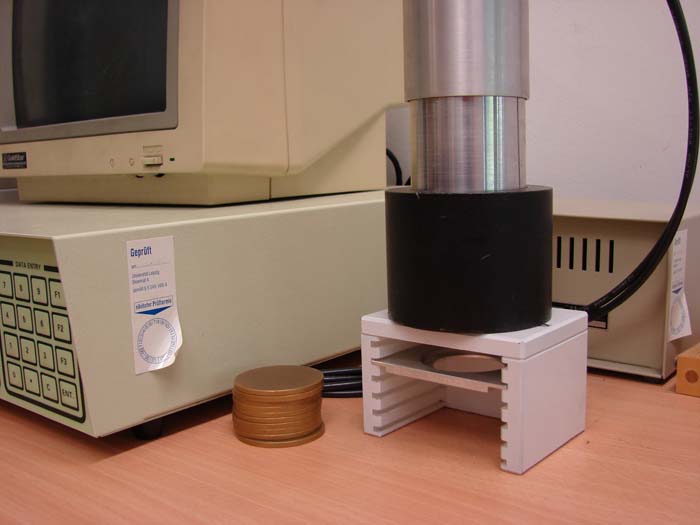ISO 18589-7 Gamma-Ray Measurement of Cesium-137
The ISO 18589 series provides a standardized framework for the measurement and quantification of specific radionuclides in environmental, industrial, and medical contexts. Among these standards, ISO 18589-7 specifically addresses the gamma-ray spectrometry measurement of Cesium-137 (Cs-137). This radionuclide is a common tracer used for measuring radioactive contamination in soil, water, and other media due to its widespread use in nuclear power plants and medical facilities.
Cesium-137 has a half-life of approximately 30.2 years and emits gamma radiation primarily at 662 keV. Its presence can indicate historical nuclear accidents or ongoing contamination risks. Accurate measurement is crucial for regulatory compliance, environmental monitoring, and public health protection.
The ISO 18589-7 standard outlines the procedures for setting up a gamma-ray spectrometer, calibrating it to measure Cs-137 accurately, and interpreting the results. This ensures that measurements are consistent across different laboratories worldwide, enhancing reliability and comparability of data.
Our laboratory adheres strictly to this international standard when performing ISO 18589-7 gamma-ray measurements. Our team of experts uses state-of-the-art equipment, including high-purity germanium (HPGe) detectors, to ensure precise detection and quantification of Cs-137.
Here’s a brief overview of the process:
- Sample Preparation: Samples are prepared by carefully homogenizing solid materials or dissolving them in appropriate solvents. This ensures that all parts of the sample contribute equally to the measurement, minimizing variability.
- Spectrometer Setup: The gamma-ray spectrometer is calibrated against a known standard source of Cs-137. This step ensures accurate and reliable measurements.
- Data Collection: Once the instrument is properly set up, it collects data on the intensity and energy spectrum of the emitted gamma rays from the sample.
- Analysis: The collected data are analyzed to determine the concentration of Cs-137. This involves comparing the measured spectrum against a reference spectrum provided by ISO 18589-7.
The results are reported according to the standard format detailed in ISO 18589-7, providing detailed information on the detected radionuclide and any associated uncertainties. This level of detail is critical for stakeholders involved in environmental monitoring, waste management, and nuclear safety.
Our laboratory has extensive experience with this service, having successfully conducted thousands of tests across various sectors including nuclear power, medical waste disposal, and environmental remediation. Our expertise ensures that every measurement adheres to the highest standards set by ISO 18589-7.
Benefits
- Regulatory Compliance: Ensures adherence to international and local regulations related to radioactive contamination.
- Precision Measurement: Provides accurate quantification of Cs-137, crucial for environmental monitoring.
- Data Reliability: Consistent results across different laboratories due to standardized measurement techniques.
- Environmental Protection: Helps in identifying and managing radioactive contamination sources effectively.
The precision and reliability of our measurements are paramount. By adhering strictly to ISO 18589-7, we ensure that the data generated is robust and can be trusted for decision-making processes.
Why Choose This Test
The ISO 18589-7 gamma-ray measurement of Cs-137 offers several advantages over other testing methods. It provides a standardized approach that ensures consistency and accuracy in results, which is particularly important for regulatory compliance.
International Standardization: The method aligns with international standards, ensuring compatibility and comparability across different jurisdictions. This is critical for global operations or when working on projects involving multiple countries.
Scientific Rigor: The procedure involves precise measurement techniques that minimize errors and provide reliable data. This scientific rigor is essential for making informed decisions based on accurate information.
Expertise: Our team of experts ensures that the test is conducted with the highest level of skill and knowledge, providing clients with confidence in the results.
Comprehensive Reporting: Detailed reports are provided, which include all relevant data points necessary for comprehensive understanding. This includes not only the concentration of Cs-137 but also any associated uncertainties and potential sources of contamination.
Customer Impact and Satisfaction
- Regulatory Compliance: Clients can ensure they are meeting all relevant regulatory requirements, reducing the risk of penalties or legal issues.
- Data Reliability: Reliable data enhances decision-making processes, leading to more effective management strategies.
- Risk Management: Identifying and managing radioactive contamination risks helps in maintaining a safe environment for workers and the public.
- Operational Efficiency: Accurate measurements allow for efficient resource allocation and operational planning.
We strive to exceed customer expectations by providing accurate, reliable, and timely results. Our commitment to excellence ensures that our clients can trust us with their most critical testing needs.





